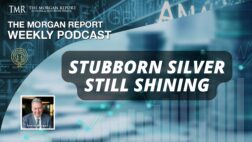The Morgan Report publisher says a tightly held silver supply putting pressure on prices as the macroeconomic climate fails to improve.
David Morgan, publisher of The Morgan Report, a monthly newsletter that covers economic news, currency and precious metals, believes that silver will be persistent this year in trying to break through its resistance of $50 an ounce. A tightly held silver supply, continued sovereign debt concerns in Europe and a strong appetite for the white metal at the start of the year are factors that he says will make silver a leader in the commodity sector in 2012. HAI Managing Editor Drew Voros recently caught up with Morgan to discuss what’s in store for the silver market this year.
Hard Assets Investor: Silver is starting out 2012 strongly. Is it following gold or is it blazing its own path?
David Morgan: Silver is following gold, but if you study silver carefully, there are times when silver leads and gold lags.
A quick example was last year. We saw silver basically double from around the $25level to $48, in a matter of months. That ended about May 1. Gold did a similar parabolic move, but not quite the percentage gain that silver outlined, but it did it later in the year. So who went parabolic first, silver or gold? Well, in this case, silver did.
HAI: Why do you think silver’s volatility was more intense last year than gold? Was it the drop-off in industrial demand?
Morgan: No it wasn’t. It was purely the momentum players, the guys that sit in front of computer screens all day who see a momentum move. They know it’s a small market. They know they can get extreme leverage in the market and they can use derivatives. And that, of course, causes the price to continue further down.
HAI: Yesterday [Jan. 11, 2012] we saw a large spike in silver sales and price attributed to Sprott Asset Management making a big purchase for its physical silver exchange-traded fund. Are some of these ETFs driving the metals markets?
Morgan: They do, absolutely. But relative to what’s mined in the silver sector, which is about 750 million ounces on an annual basis, the 9 million ounces purchased were not really that large. But what that indicates strongly is that the flow is tight. In other words, there are not all these warehouses full of silver. Supply is in tightly held hands. It’s all held either for investors longer term and/or by industrial users that don’t really stockpile very much. What yesterday’s purchase shows is that whatever comes out of the pipeline has got a lot of people waiting at the end of that pipeline.
HAI: Do you see more silver funds coming to the market, or is there a risk here that we’re going to get saturated?
Morgan: At some point all markets get overdone. And, as bullish as I am, silver probably will at some point. I do see more silver funds coming in. In fact, I’m actually aware of a couple that are being formed as we speak. There will be more demand. But I think the big question implied is, when will it stop? The answer to that is the global financial system is in such dire straits right now, that more and more people are gravitating to the precious metals. And that trend will continue, which implies more ETFs, more hedge funds, more silver mutual funds, more holding companies and everything else throughout the sector.
HAI: Where do you see the strongest industrial demand for silver coming from?
Morgan: Solar is No. 1 right now and is growing rapidly, almost exponentially. It will level off probably by 2014.
HAI: Where do you think silver is headed in terms of price this year?
Morgan: I’m on record saying $60 by the end of the year. And it will probably take all year to get there. The key is to get through that $50 psychological barrier. It’s probably going to take a couple of tries. And I do believe at some point it will. Once it does that, you could see silver go up from $50 to $60 in a matter of two weeks. That’s the kind of move silver is capable of making.
HAI: Let’s talk a little bit about miners. Have the silver miners been as undervalued as some of the gold miners?
Morgan: It depends on a case-by-case basis, but you’re right. The silver mining industry has got the biggest premium in the sector. A good silver miner producing silver at the top of the market in the last bull market sold at 50-to-1 P/E [price-earnings ratio], whereas gold miners were selling about at 35-to-1 P/E. So silver carries a premium. And you see that throughout the sector. There are some very undervalued mining stocks, including some silver stocks in this juncture.
HAI: What is some advice you would offer someone who’s thinking about getting into silver for the first time? What kind of entry point would you suggest?
Morgan: I would say get both gold and silver. There is a program I’m associated with: www.SilverSaver.[LLB1] com. That program is a dollar-cost-averaging program. Just put in the same amount every month and don’t worry about it. If the market goes down, you’re buying more silver. If the market goes up, you’re buying less silver. It’s a great professional way to handle any market, especially a volatile market like the silver market.
HAI: Do you prefer bullion or coins?
Morgan: I prefer coins. I think you want small denominations. That would serve you best in exiting the market, because you have a small unit, you can sell just part of your holdings. Once you get to the bullion, then you’re making bigger decisions. Is it 100 ounces at a time? Is it 1,000 ounces at a time? I try to get everyone to start with coins. But it depends on the individual. If you’re a well-heeled investor and committed to the silver market, you should have a mix of both.
HAI: What coins would you recommend specifically?
Morgan: One rule is to buy as much silver as you can per dollar invested, which implies getting silver rounds, which are privately minted silver coins, not government minted. The government-minted coins are exactly the same in weight and content, which is 0.999 silver. But they have the government stamps on them, which puts a big premium on those.
If you get one any of these private mints, it’s the same exact thing, except it’s not a government mint that’s stamping it out. Nonetheless, it’s just as pure, just as fine, the same weight. But again, it comes down to the individual. Someone says, “No, no, I’ve got to have a government stamp on my coin.” Well then, do that. You’re just going to pay more.
HAI: The U.S. Mint said there was a record amount of silver coins purchased in the first two weeks of the year. What was behind that?
Morgan: Silver is becoming a more popular investment, so a lot of these dealers will buy huge amounts of freshly minted 2012s. They’ll slab them, which means put them in a plastic holder, and get them graded, and then put a huge price tag on them. As far as I’m concerned, it’s a big rip-off. They then sell them for $100 each, when there’s $30 worth of silver in the coin. So that’s part of it right there
HAI: Let’s talk a little bit about asset allocation. What do you recommend when it comes to precious metals?
Morgan: I recommend 20 percent into metals, but it also depends on your age. Because the younger you are, the more risk you can take. If you’re age 60 years or older, half of that would be in physical metal. The 10 percent remaining is done like this: About 70 to 80 percent of that goes into top-tier, cash-rich unhedged mining companies; about 20 percent goes into midtiers; and the remaining 10 percent is spread out among junior miners.
HAI: Do you, at times, recommend selling silver?
Morgan: Absolutely. I got out of silver at $48/oz. on that move up last year, but not all of my position. But it’s very nice to capture $19 on the move to $48, which is basically what I did.
So I do trade, and I do invest. And they’re different topics. One is to make money and go back into cash. The other is just to buy and hold for the long term. Not everybody can do both. But I’ve been doing it for years and years, and I’m comfortable with that methodology.
(Follow David Morgan at www.silver-investor.com)



